Creating effective marketing campaigns that resonate with customers is crucial for any business aiming to build a loyal customer base. To achieve this, it’s essential to have a deep understanding of your target audience, their needs, and preferences.
Understanding your audience is the foundation of developing a campaign strategy that drives customer engagement and loyalty. By knowing what your customers love, you can tailor your campaigns to meet their expectations, thereby enhancing their overall experience with your brand.

Throughout this article, we will explore the strategies and techniques to develop effective marketing campaigns. We’ll delve into understanding your target audience and crafting campaigns that speak to them.
Table of Contents
Why do traditional ads feel pushy?
Traditional ads often feel pushy because they interrupt the audience rather than engage them. They rely heavily on one-way communication, focusing on broadcasting a message rather than understanding the consumer’s needs or interests. This approach tends to prioritize the brand’s goals—such as promoting a product or increasing sales—over creating a meaningful connection with potential customers. As a result, viewers may feel pressured or manipulated, especially when the ad repeats frequently or uses aggressive calls-to-action. Unlike modern, personalized marketing strategies that leverage data to deliver relevant content, traditional ads can feel generic, intrusive, and detached from the consumer’s actual preferences, which amplifies the sense of being “sold to” rather than being invited into a conversation.
What’s the difference between forced marketing and engagement?
The difference between forced marketing and engagement lies in the approach and the relationship a brand builds with its audience. Forced marketing typically involves pushing messages, promotions, or advertisements onto consumers without considering their interests, preferences, or needs. It’s intrusive, often interruptive, and can create resistance or even negative perceptions of the brand. Engagement, on the other hand, is centered around building genuine connections with the audience by providing value, sparking conversations, and encouraging interaction. Rather than imposing a message, engagement focuses on understanding the customer, fostering trust, and creating experiences that resonate. In essence, while forced marketing is about broadcasting, engagement is about connecting—and it’s this connection that drives loyalty, advocacy, and long-term customer relationships.
Are your marketing campaigns truly connecting with your customers?
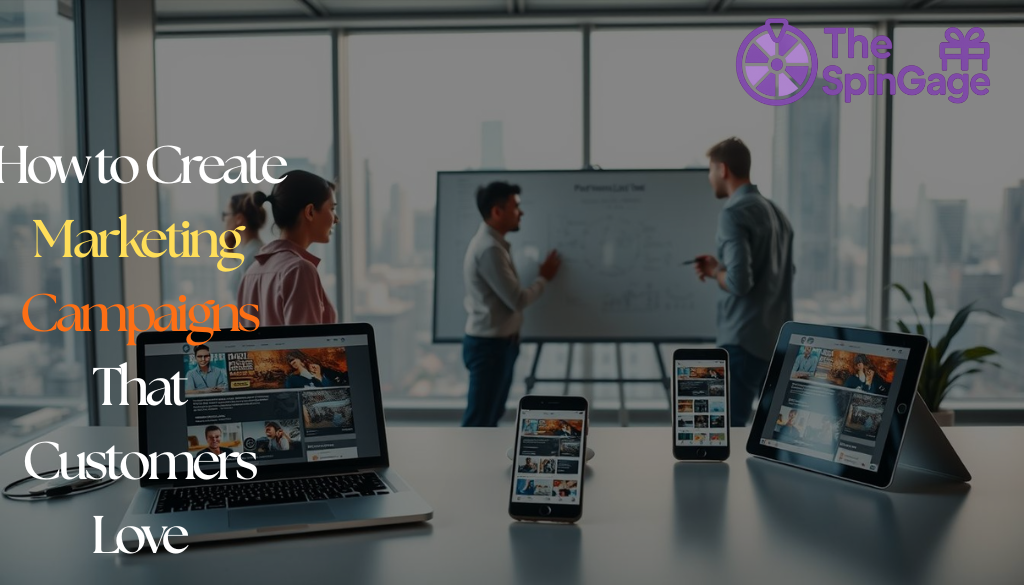
In today’s fast-paced digital world, creating campaigns that not only reach your audience but deeply resonate with them is no longer optional—it’s essential. At The Spin Gage, we guide businesses through the process of understanding their customers’ needs, behaviors, and emotional triggers to craft campaigns that inspire engagement, loyalty, and meaningful interactions. From conducting effective customer research and building detailed personas to leveraging psychological insights and multi-channel strategies, our approach ensures your marketing efforts are not just seen—but felt. Imagine campaigns tailored to your audience’s preferences, driving higher conversions, fostering trust, and building lasting brand connections.
How does SpinGage turn marketing into a fun experience?
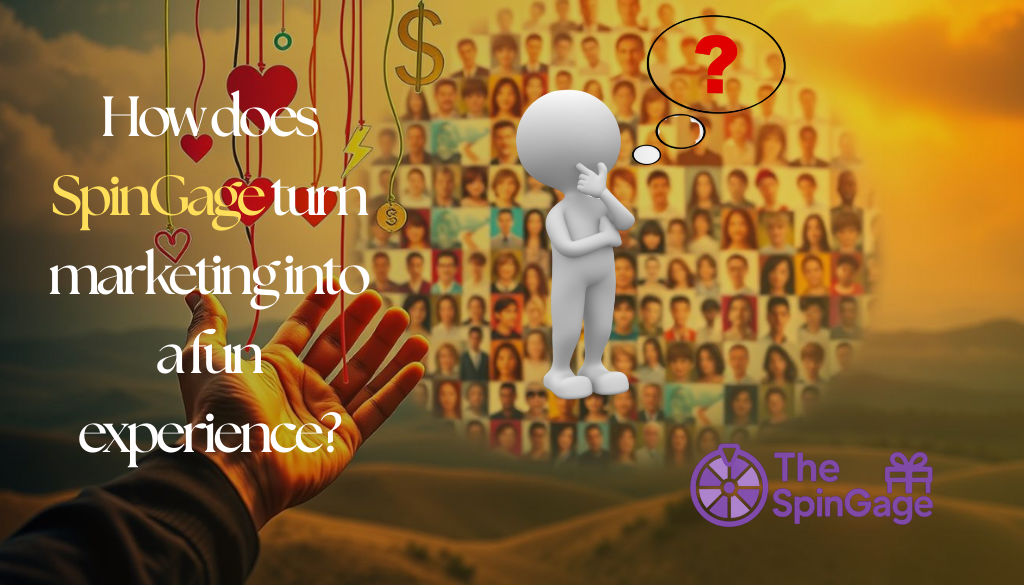
How does SpinGage turn marketing into a fun experience? SpinGage transforms marketing from a routine business task into an engaging and interactive experience by focusing on creativity, personalization, and gamification. Instead of relying solely on traditional promotional strategies, SpinGage leverages innovative tools that allow brands to connect with their audiences in memorable ways. By incorporating interactive content, playful campaigns, and visually appealing designs, the platform encourages customer participation and fosters genuine engagement. Moreover, SpinGage emphasizes understanding audience behavior and preferences, tailoring campaigns that feel less like advertisements and more like enjoyable experiences. This approach not only captures attention but also builds stronger emotional connections with customers, turning marketing into a fun, rewarding, and impactful journey for both businesses and their audiences.
How does SpinGage automate review collection?
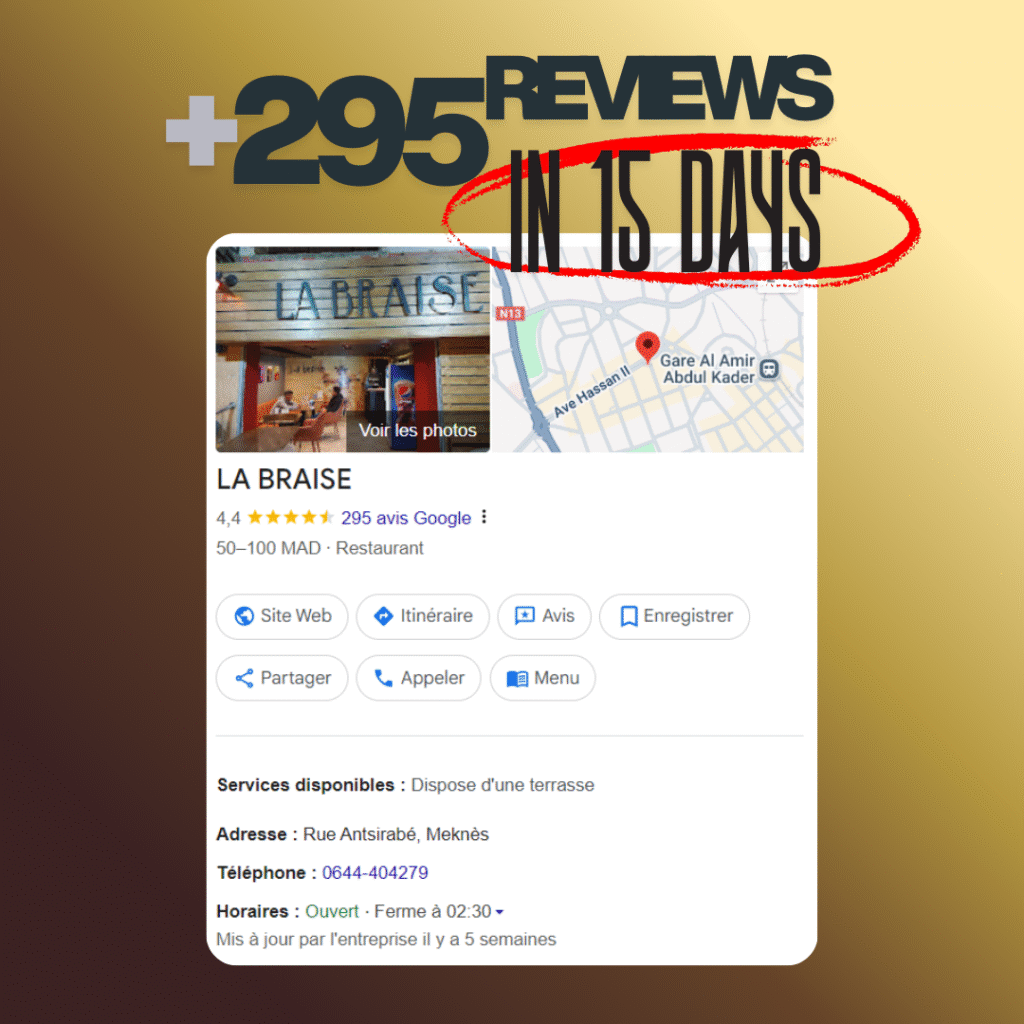
+295 REVIEWS IN JUST 15 DAYS :
Labraise is a restaurant that gained more than 295 new customer reviews and increased their income by using TheSpinGage solution.
They placed a flyer with a QR code on every table, allowing each diner to scan and spin the wheel. Labraise used a 100% winning ratio plan, where customers always won either 10% off their meal or a free soda.
This simple gamification encouraged guests to leave reviews, boosted loyalty, and kept customers coming back.

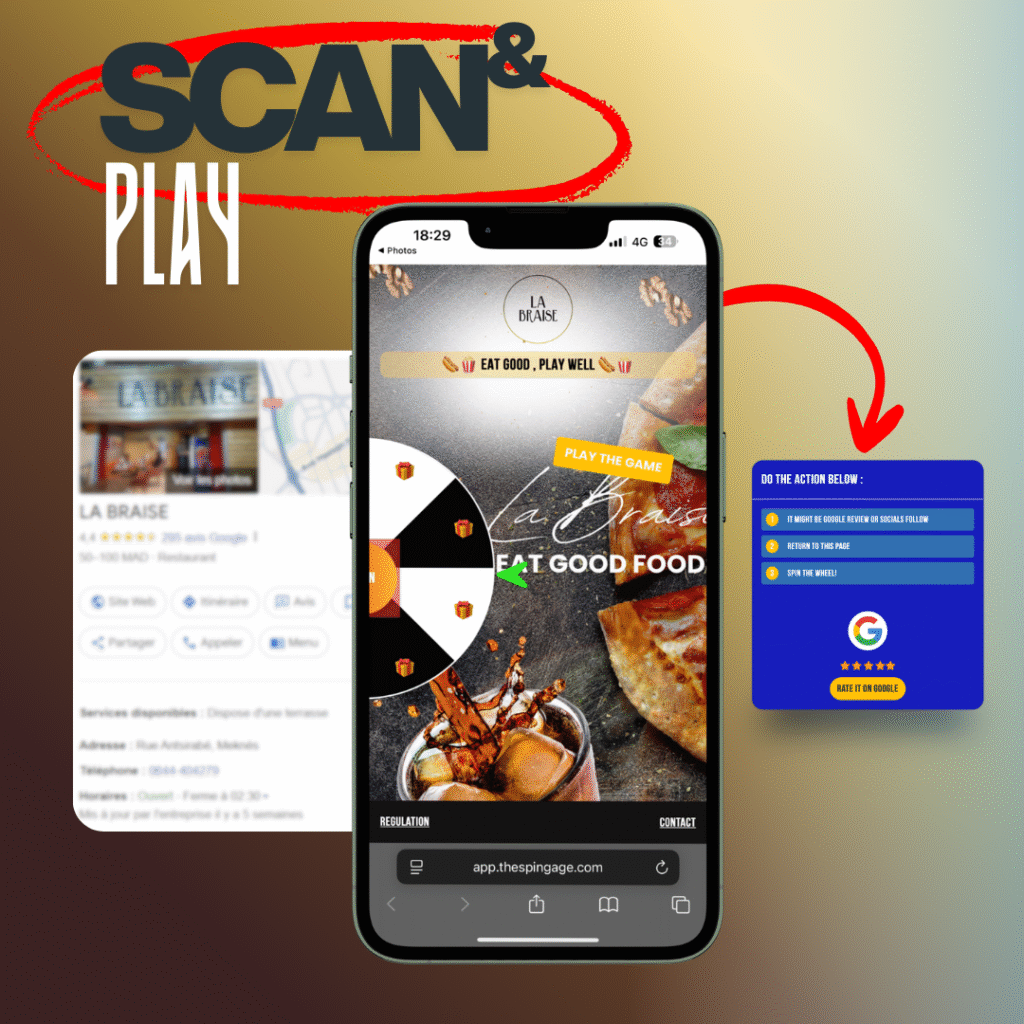
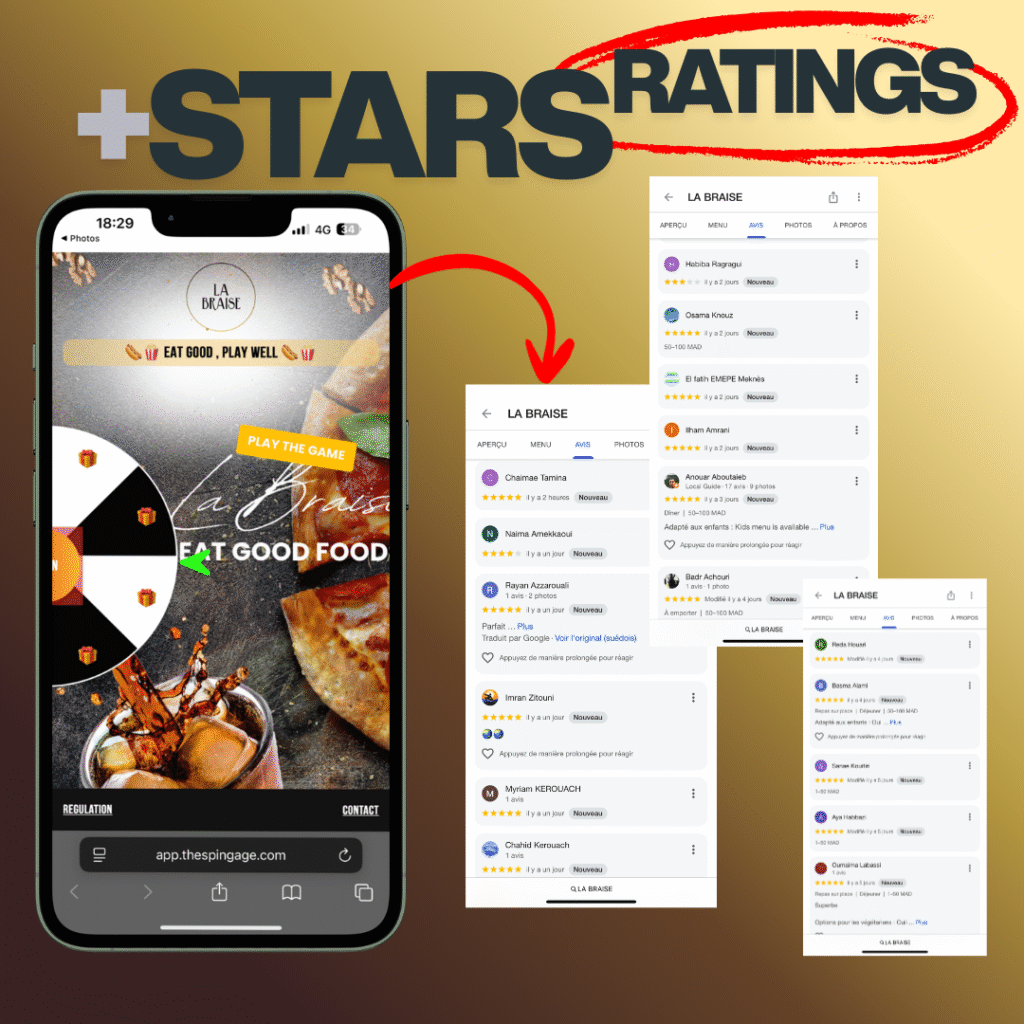
HOW IT WORKS IN 4 EASY STEPS ?
1 – Scan the QR Code
Clients simply scan the QR code placed on the table or provided directly by you.
2- Take Action First
To unlock the gameplay, they must complete the required action.
3- Spin the Wheel
Once unlocked, they spin the wheel to test their luck.
4- Win Rewards
If they win, a QR code is instantly sent to their email. If not, nothing happens. In both cases, the game is locked for 24 hours, ensuring fairness and excitement for the next try.
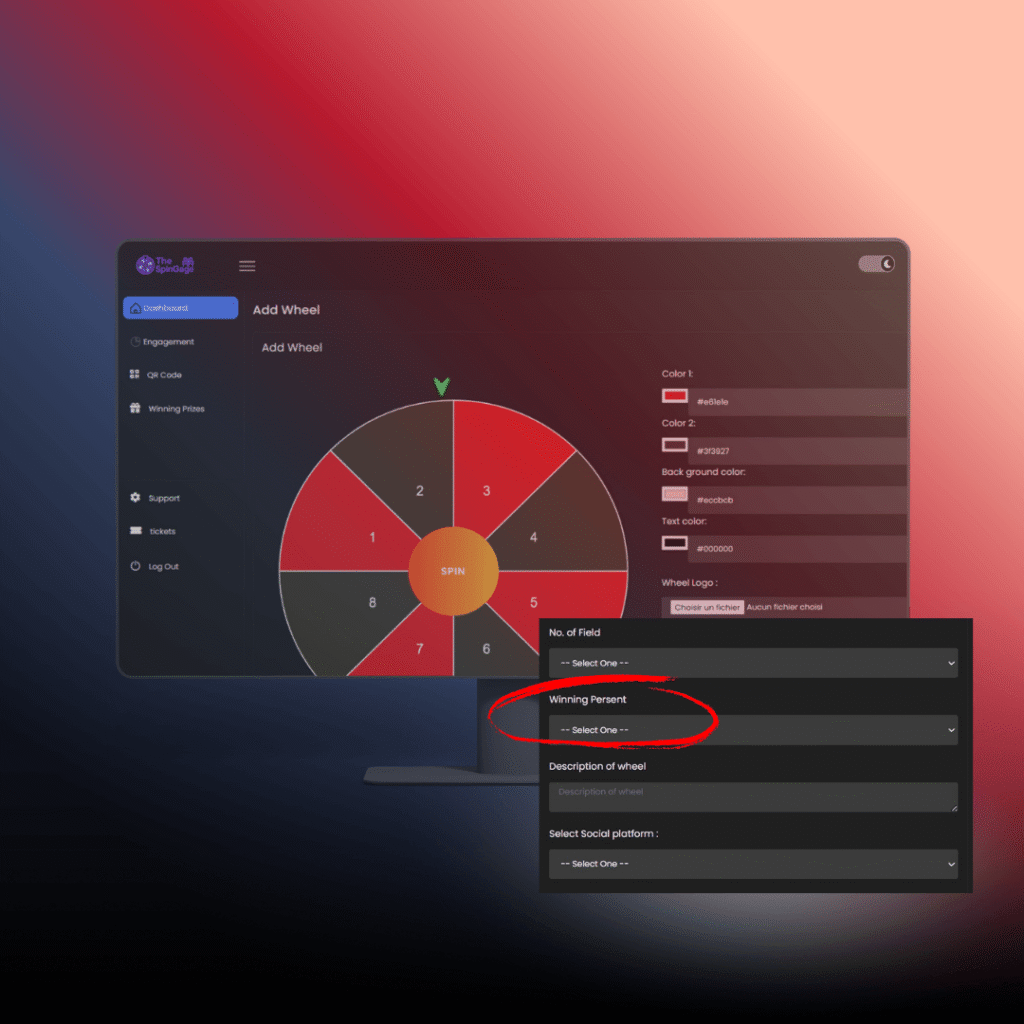
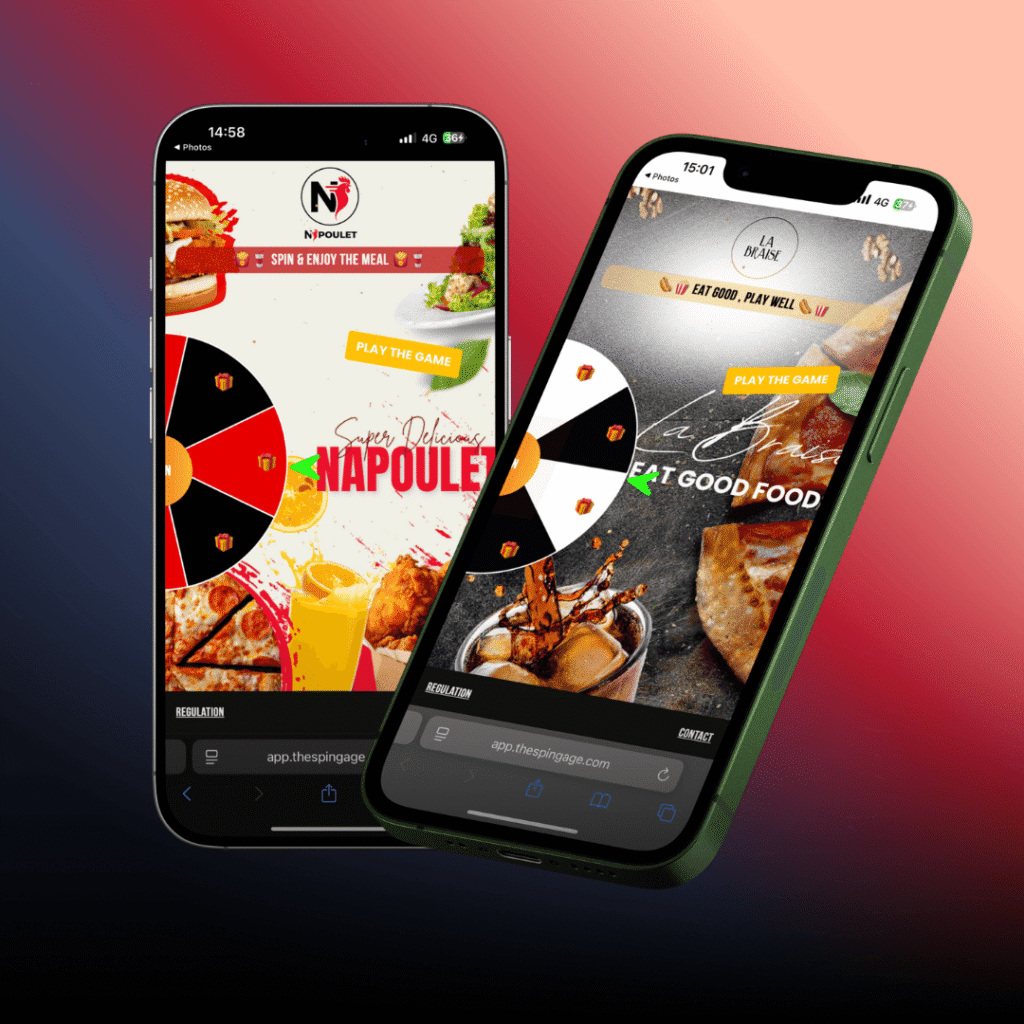
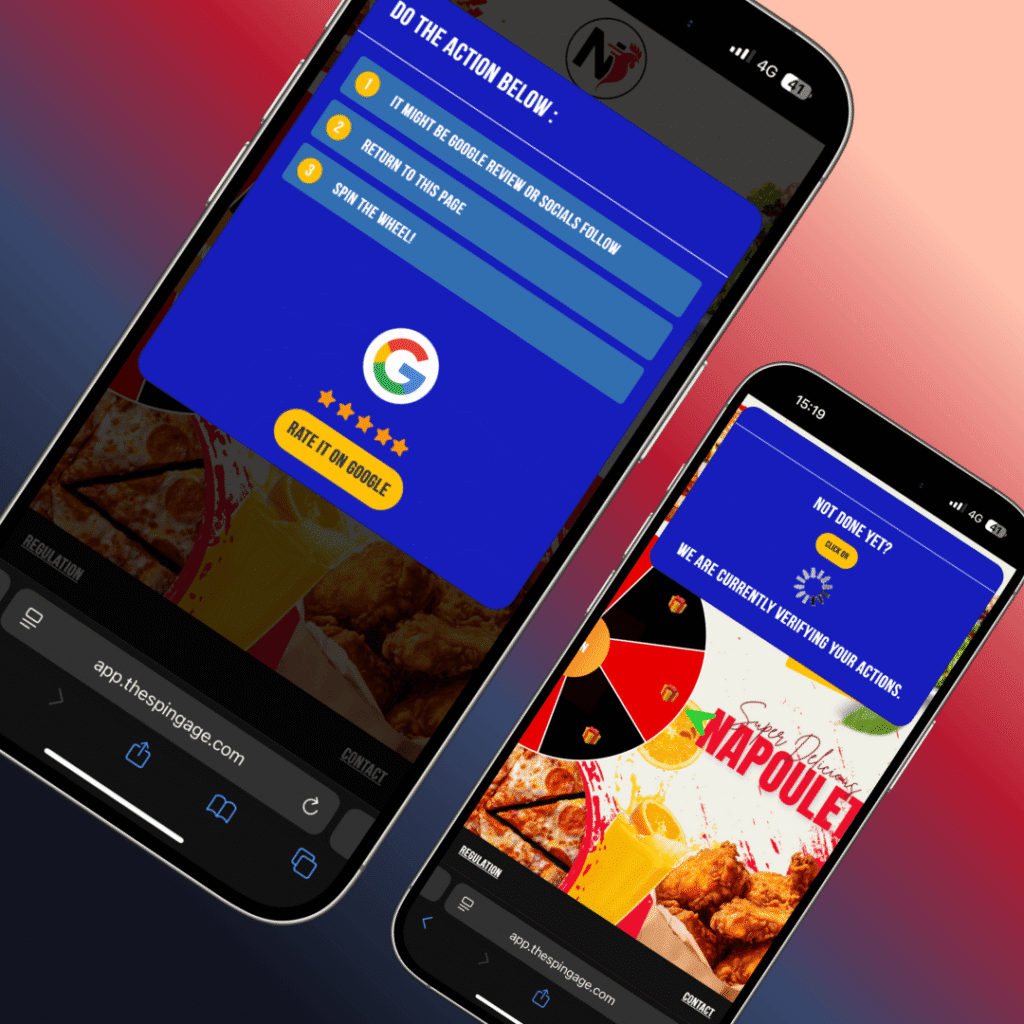
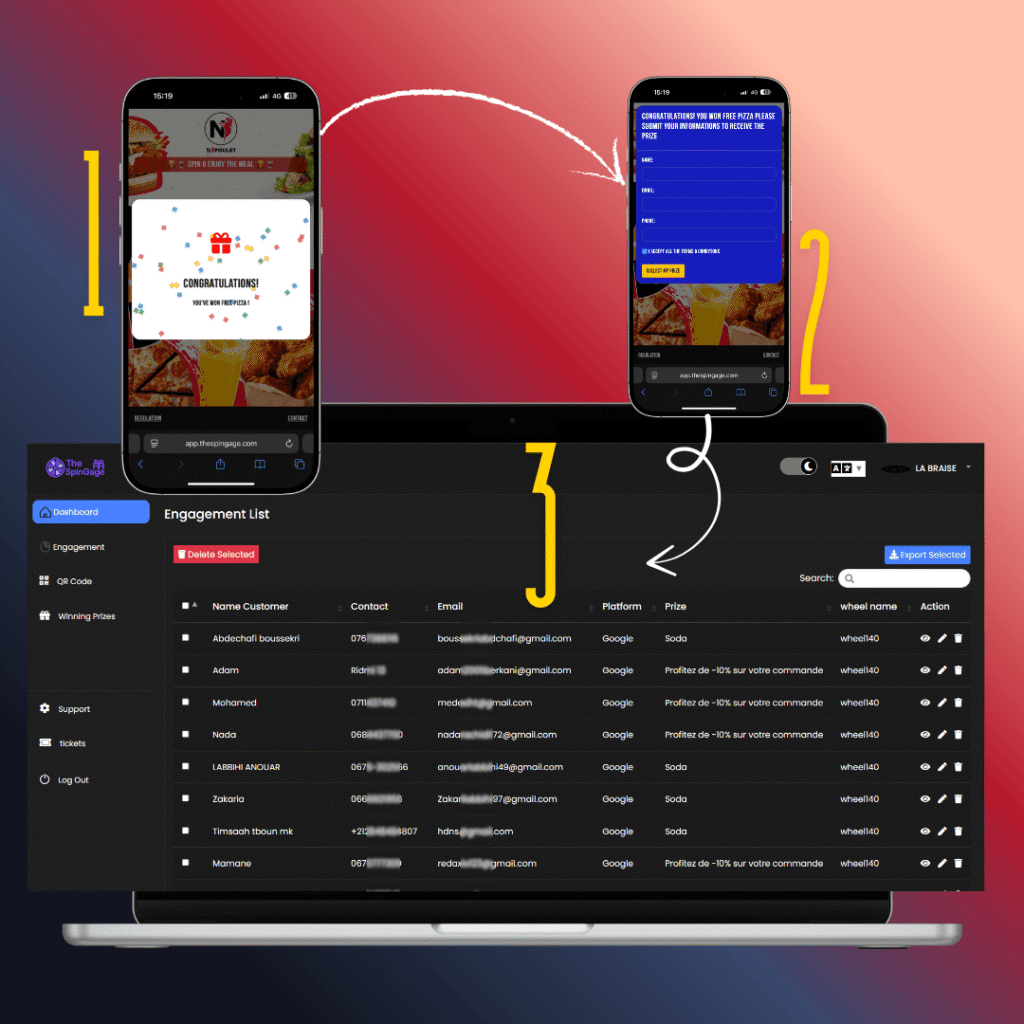
🛠️ Flexible Tracking Options
Track platform Top performing .
Track the wheel segments (number of prizes, Winner Gameplay).
Number of Plays , Track top performing wheel
Set up expiration dates for vouchers and offers.
Get Acces to LEADS , Extraxt & Modiify it .
Why You Should Opt for TheSpinGage Solution
Running a business today is not just about serving customers – it’s about creating memorable experiences that keep them coming back and spreading the word. That’s exactly what TheSpinGage delivers.
🎯 Stand Out from Your Competitors
Most restaurants, cafés, and shops rely only on discounts or word of mouth. With TheSpinGage, you turn every visit into a fun, interactive moment that clients remember and talk about.
⭐ Collect More Positive Reviews
Google reviews are the new “digital reputation.” Our system motivates clients to leave reviews in exchange for a chance to win rewards – giving you the social proof that attracts new clients effortlessly.
💌 Grow Your Customer Database
Every spin is an opportunity to collect emails and data, helping you stay connected with your clients through newsletters, promotions, and loyalty campaigns.
🔄 Boost Loyalty and Repeat Visits
Customers love rewards. By making every visit a chance to win, you encourage repeat visits, turning occasional clients into loyal fans of your business.
⚡ 100% Simple & Automated
No technical headaches. Once installed, TheSpinGage works automatically – whether through QR codes on tables, flyers, or digital screens. You just set the rules, and the system does the rest.
👉 TheSpinGage isn’t just a tool – it’s your new customer magnet.
Increase engagement, grow your reviews, and build a strong database without spending more on ads.
📲 Activate TheSpinGage today and turn visitors into loyal, returning customers!
START TODAY
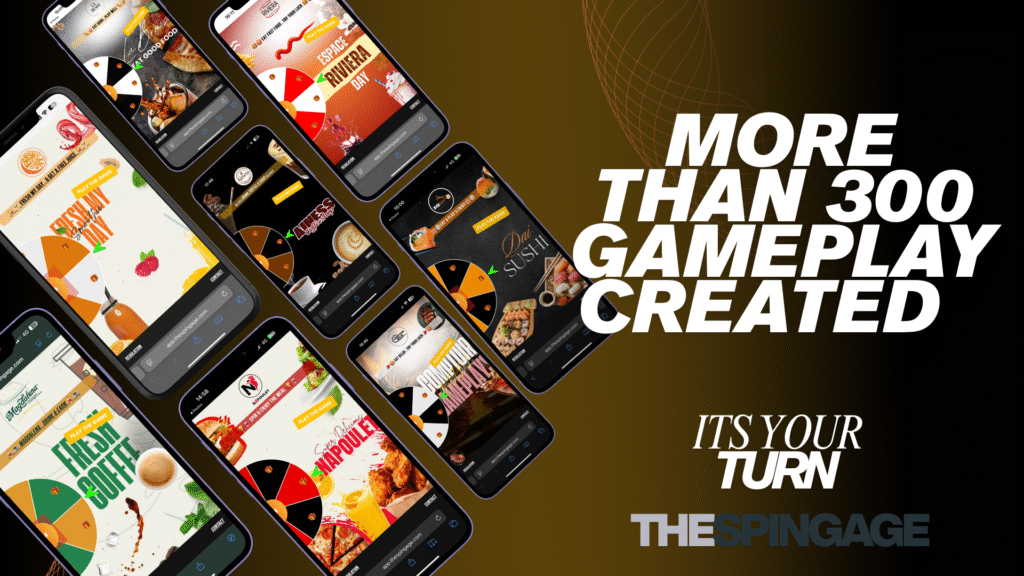
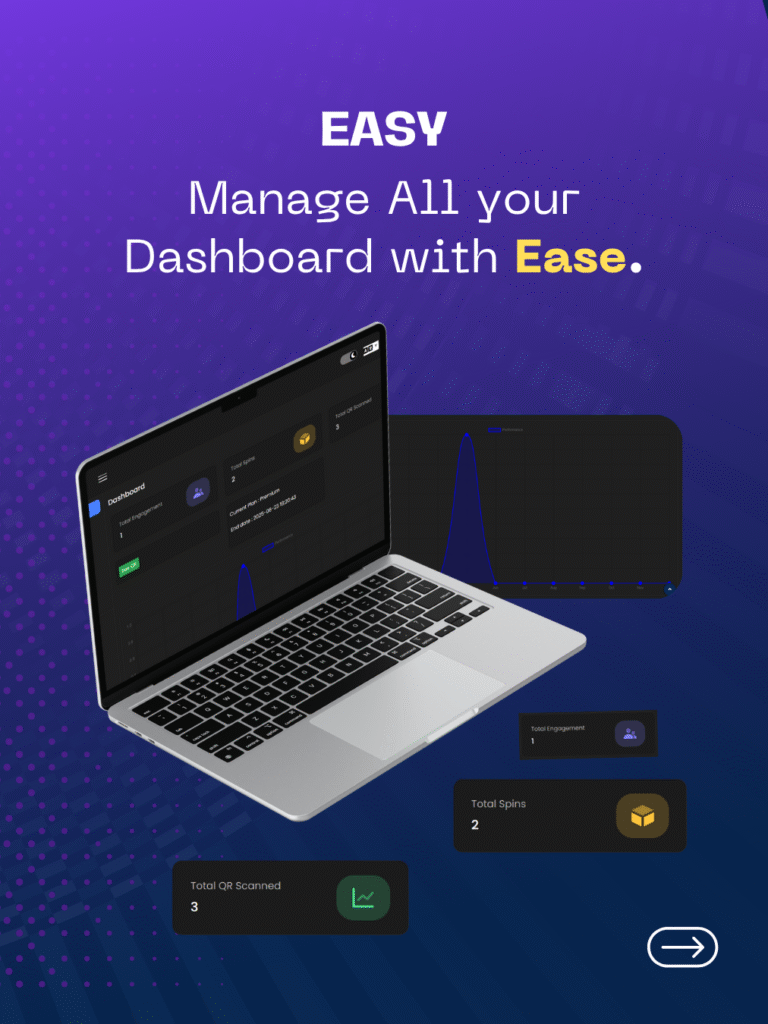
SpinGage automates review collection by seamlessly integrating with your business platforms to prompt customers for feedback at the right moment. It can automatically send personalized review requests via email or SMS after a purchase or service, making it easy for customers to share their experiences. This automation not only increases the volume of reviews but also ensures consistent and timely feedback, helping businesses maintain a strong online reputation without manual effort.
Combine this with strategic local SEO practices, including keyword research, category optimization, and building citations and backlinks, and you’re positioning your business to dominate local se
Don’t leave your success to chance—empower your brand with strategies that customers genuinely love.
Start Crafting Your Winning Campaign Today →
Understanding Your Target Audience
To create marketing campaigns that resonate with customers, it’s essential to have a deep understanding of your target audience. This involves gaining insights into their needs, preferences, and behaviors to develop targeted and effective marketing strategies.

Conducting Effective Customer Research
Effective customer research is the foundation of understanding your target audience. It involves gathering data through various methods to gain a comprehensive understanding of your customers.
Surveys and Feedback Collection Methods
Surveys and feedback collection are crucial for understanding customer satisfaction and preferences. Online surveys and social media feedback are effective tools for gathering this information. By analyzing customer responses, businesses can identify areas for improvement and tailor their marketing efforts accordingly.
Analyzing Customer Behavior Data
Analyzing customer behavior data provides valuable insights into how customers interact with your brand. This includes examining purchase history, website interactions, and other behavioral patterns. By understanding these behaviors, businesses can develop targeted marketing campaigns that resonate with their audience.
Creating Detailed Customer Personas
Creating detailed customer personas is a critical step in understanding your target audience. Personas help businesses tailor their marketing efforts to specific customer segments.
Demographics vs. Psychographics
Understanding the difference between demographics and psychographics is essential for creating effective customer personas. Demographics include characteristics such as age, gender, and income, while psychographics involve understanding customer values, interests, and lifestyles. By combining both, businesses can develop a comprehensive understanding of their target audience.
Journey Mapping for Better Campaign Targeting
Journey mapping involves understanding the customer’s journey from awareness to conversion. By mapping this journey, businesses can identify touchpoints and develop targeted marketing campaigns that resonate with their audience at each stage.
The Psychology Behind Successful Marketing Campaigns
To create marketing campaigns that customers love, marketers must delve into the psychology of customer engagement. Understanding what drives customer behavior and decision-making is crucial for devising campaigns that resonate.
Emotional Triggers That Drive Customer Engagement
Emotional triggers play a significant role in capturing customer attention and driving engagement. Techniques such as creating a sense of urgency or scarcity can significantly impact customer behavior.
Using FOMO and Scarcity Effectively
Using FOMO (Fear of Missing Out) and scarcity tactics can motivate customers to take action. Limited-time offers or limited availability can create a sense of urgency.
Creating Positive Emotional Associations
Creating positive emotional associations with a brand can lead to customer loyalty. Brands that evoke positive emotions are more likely to be remembered and chosen by customers.
Building Trust and Authenticity
Building trust with customers is fundamental to the success of any marketing campaign. Trust can be fostered through transparency and social proof.
Transparency in Marketing Messages
Transparent marketing messages help build credibility with customers. Being honest and clear in communications can significantly enhance trust.
Social Proof and Testimonial Integration
Using social proof, such as customer testimonials, can reinforce trust and authenticity. Customers are more likely to engage with brands that have positive reviews and testimonials.
| Technique | Description | Impact on Customer Engagement |
|---|---|---|
| FOMO | Creating a sense of urgency | High |
| Scarcity | Limited availability | High |
| Social Proof | Customer testimonials | Medium-High |
| Transparency | Honest marketing messages | Medium |
Planning Your Marketing Campaigns for Maximum Impact
Planning a marketing campaign requires a multifaceted approach, including setting clear objectives, developing a comprehensive strategy, and allocating resources effectively. This foundational step is crucial for ensuring that your campaign resonates with your target audience and achieves the desired outcomes.
Setting Clear Campaign Objectives
Clear campaign objectives are the foundation upon which successful marketing campaigns are built. These objectives should be specific, measurable, achievable, relevant, and time-bound (SMART), providing a clear direction for your campaign.
Developing a Comprehensive Campaign Strategy
A comprehensive campaign strategy outlines how you will achieve your campaign objectives. It involves understanding your target audience, selecting the right marketing channels, and crafting messages that resonate.
Timeline Development and Milestone Setting
Creating a detailed timeline and setting milestones are critical components of a campaign strategy. This ensures that your campaign stays on track and that progress can be monitored effectively.
Budget Allocation and ROI Projections
Effective resource allocation involves not only assigning a budget but also projecting the return on investment (ROI). This helps in making informed decisions and in optimizing your campaign for better performance.
Allocating Resources Effectively
Resource allocation is about more than just budgeting; it’s about ensuring that the right resources are available at the right time to execute your campaign strategy. This includes human resources, technology, and financial resources.
By focusing on clear objectives, a robust strategy, and effective resource allocation, businesses can create marketing campaigns that not only resonate with their audience but also drive significant results. Companies like Coca-Cola have demonstrated the power of well-planned marketing campaigns, achieving substantial ROI through meticulous planning and execution.
Creating Compelling Content That Resonates
Crafting content that resonates with your audience is crucial for a successful marketing campaign. Compelling content not only captures the attention of your target audience but also fosters a deeper connection with them. To achieve this, marketers can leverage various techniques, including storytelling, visual elements, and persuasive messaging.
Storytelling Techniques That Captivate Audiences
Storytelling is a powerful tool in marketing that can captivate audiences and make your brand more relatable. By using narratives, brands can create an emotional connection with their audience.
Hero’s Journey Framework in Marketing
The Hero’s Journey framework is a popular storytelling technique that can be applied to marketing. It involves a transformative journey where the customer is the hero, and your brand is the guide that helps them overcome challenges.
Creating Relatable Brand Narratives
Creating relatable brand narratives involves understanding your audience’s values, desires, and pain points. By crafting stories that reflect these elements, brands can build a stronger connection with their audience.

Visual Elements That Enhance Campaign Effectiveness
Visual elements play a crucial role in enhancing the effectiveness of marketing campaigns. Images, videos, and graphics can help capture the audience’s attention and convey complex information in a more digestible format.
Crafting Persuasive Messaging
Crafting persuasive messaging involves using language that resonates with your audience and motivates them to take action. Power words and conversion-focused copy can significantly enhance the persuasiveness of your messaging.
Power Words and Conversion-Focused Copy
Using power words and crafting conversion-focused copy can help drive conversions. Power words are words that evoke emotions and encourage action.
Call-to-Action Optimization
Optimizing your call-to-action (CTA) is critical for converting leads into customers. A well-crafted CTA should be clear, direct, and actionable.
As
“The goal of marketing is to own a word in the prospect’s mind.” – Al Ries
, creating compelling content that resonates with your audience is key to achieving this goal.
Personalization Strategies for Modern Marketing Campaigns
In today’s competitive marketing landscape, personalization has become a crucial element in creating campaigns that resonate with customers. By tailoring messages and experiences to individual preferences and behaviors, businesses can significantly enhance customer engagement and loyalty.
Leveraging Customer Data for Personalization
Effective personalization relies heavily on the quality and depth of customer data. By collecting and analyzing data on customer interactions, preferences, and behaviors, marketers can create highly targeted campaigns.
First-Party Data Collection Best Practices
Collecting first-party data directly from customers is crucial for personalization. Best practices include using website cookies, surveys, and sign-up forms to gather relevant information. Ensuring transparency and consent in data collection is also vital.
Segmentation Techniques for Targeted Messaging
Segmentation involves dividing the customer base into distinct groups based on shared characteristics. Techniques include demographic, behavioral, and firmographic segmentation, allowing for highly targeted messaging that resonates with each group.
Dynamic Content Creation
Dynamic content creation involves generating content that adapts to the individual customer’s preferences and behaviors in real-time. This approach ensures that customers receive relevant and engaging content.
Automated Personalization Tools
Automated personalization tools use algorithms to analyze customer data and deliver personalized content. These tools enable marketers to scale their personalization efforts efficiently.
A/B Testing for Personalized Experiences
A/B testing is crucial for optimizing personalized experiences. By testing different versions of content and messaging, marketers can identify the most effective approaches and refine their strategies accordingly.
By implementing these personalization strategies, businesses can create marketing campaigns that are not only engaging but also deeply resonant with their target audience.
Multi-Channel Marketing Campaigns That Drive Results
As consumers increasingly interact with brands across various platforms, multi-channel marketing campaigns have become essential for driving business results. In today’s digital landscape, customers expect a seamless experience across different touchpoints, making it crucial for businesses to adopt a cohesive marketing strategy.

Selecting the Right Channels for Your Audience
Understanding your target audience is key to selecting the most effective channels for your multi-channel marketing campaigns. By analyzing customer behavior and preferences, you can identify the platforms where your audience is most active and engaged. This enables you to allocate resources efficiently and maximize campaign impact.
Creating Cohesive Cross-Channel Experiences
Creating a cohesive cross-channel experience is vital for ensuring that your marketing efforts resonate with customers. This involves aligning your messaging, visual identity, and tone across all channels to provide a consistent brand experience.
Message Consistency Across Platforms
Maintaining message consistency across different platforms is crucial for reinforcing your brand’s value proposition. By ensuring that your messaging is aligned across channels, you can build trust and credibility with your audience.
Sequential Marketing Strategies
Implementing sequential marketing strategies allows you to engage with customers at different stages of their buying journey. By tailoring your messaging and offers based on customer behavior and preferences, you can nurture leads and drive conversions.
Optimizing Channel-Specific Content
Channel-specific content optimization is critical for maximizing the effectiveness of your multi-channel marketing campaigns. This involves tailoring your content to suit the unique characteristics and user behaviors associated with each channel.
Social Media Platform Customization
Customizing your content for social media platforms requires an understanding of the unique features and user behaviors associated with each platform. By adapting your content to suit the specific requirements of each platform, you can enhance engagement and drive campaign results.
Email, Web, and Mobile Optimization
Optimizing your content for email, web, and mobile channels involves ensuring that your messaging and visual elements are tailored to the specific characteristics of each channel. This enables you to provide a seamless and engaging experience across different touchpoints.
Measuring the Success of Your Marketing Campaigns
Effective campaign measurement is the backbone of any successful marketing strategy. To understand the impact of your marketing efforts, you need to track and analyze key metrics that indicate campaign performance.
Key Performance Indicators to Track
To gauge the success of your marketing campaigns, it’s essential to monitor specific Key Performance Indicators (KPIs). These metrics provide insights into how your campaigns are performing and where improvements can be made.
Engagement Metrics That Matter
Engagement metrics such as click-through rates, likes, shares, and comments are crucial. They indicate how your audience is interacting with your campaign content.
- Click-through rates (CTR)
- Social media engagement (likes, shares, comments)
- Email open rates
Conversion and Revenue Attribution
Conversion rates and revenue attribution are vital KPIs that directly impact your bottom line. They help you understand the return on investment (ROI) of your marketing campaigns.
| KPI | Description | Importance |
|---|---|---|
| Conversion Rate | Percentage of visitors who complete a desired action | High |
| Revenue Attribution | Revenue generated from marketing campaigns | High |
Tools and Technologies for Campaign Analysis
Utilizing the right tools and technologies is crucial for effective campaign analysis. These tools help in tracking KPIs, analyzing campaign performance, and making data-driven decisions.
Analytics Platforms for Campaign Tracking
Analytics platforms like Google Analytics provide comprehensive insights into campaign performance. They help track website traffic, behavior, and conversion metrics.
“The use of analytics platforms has revolutionized the way we approach marketing campaigns, enabling us to make informed decisions based on data.”
Marketing Expert
Reporting Dashboards and Visualization
Reporting dashboards and data visualization tools help present complex data in an easily understandable format. This facilitates better decision-making and campaign optimization.
Key features of reporting dashboards include:
- Real-time data updates
- Customizable metrics and KPIs
- Data visualization (charts, graphs)
By leveraging these tools and techniques, marketers can significantly enhance the effectiveness of their campaigns, driving better engagement and conversion rates.
Case Studies: Successful Marketing Campaigns That Customers Loved
Analyzing marketing campaigns that customers love can provide a roadmap for effective brand communication. By examining both B2C and B2B successful campaigns, we can identify key strategies that drive customer engagement and conversion.
B2C Campaign Examples
B2C campaigns often focus on creating emotional connections and interactive experiences. Let’s explore some notable examples.
Emotional Connection Campaigns
Coca-Cola’s “Share a Coke” campaign is a prime example of creating an emotional connection with customers. By personalizing bottles with popular names, Coca-Cola encouraged customers to share a Coke with friends and family, fostering a sense of togetherness.
“The ‘Share a Coke’ campaign was a huge success, increasing sales and brand engagement among young adults.”
Coca-Cola’s Marketing Team
Interactive and Participatory Campaigns
Another successful B2C campaign is the “Dove Real Beauty Sketches.” This campaign invited women to describe themselves to a sketch artist who couldn’t see them, then compared these sketches to ones based on descriptions from strangers who had met the women. The campaign sparked a conversation about beauty standards and self-perception.
B2B Campaign Examples
B2B campaigns, on the other hand, often focus on value-driven educational content and relationship-building strategies. Here are a couple of examples.
Value-Driven Educational Campaigns
IBM’s “Smarter Planet” campaign educated businesses about innovative solutions for a more sustainable future. By highlighting the benefits of smart technology, IBM positioned itself as a thought leader in the industry.
| Campaign | Objective | Outcome |
|---|---|---|
| IBM Smarter Planet | Educate on smart technology | Established IBM as a thought leader |
| Dove Real Beauty Sketches | Spark conversation on beauty standards | Increased brand engagement and positive brand perception |
Relationship-Building Campaign Strategies
HubSpot’s inbound marketing campaigns are exemplary in building relationships through valuable content. By offering free educational resources, HubSpot attracts potential clients and nurtures them through the sales funnel.
Key Takeaways: Successful marketing campaigns, whether B2C or B2B, share common traits like personalization, interactivity, and a focus on delivering value. By understanding these elements, marketers can craft campaigns that resonate with their target audience.
Conclusion
Creating effective marketing campaigns is a nuanced process that hinges on understanding your target audience, leveraging psychological triggers, and personalizing your approach. By adopting a multi-channel strategy and measuring campaign success, you can develop Marketing Campaigns that foster Customer Engagement and loyalty.
A well-planned Campaign Strategy is crucial in today’s competitive landscape. It involves not just reaching your audience, but resonating with them on a deeper level. This requires a blend of compelling content, emotional triggers, and a clear understanding of your customer’s needs.
As you move forward, remember that the key to successful marketing lies in adaptability and a customer-centric approach. By staying attuned to your audience’s evolving preferences and behaviors, you can refine your Campaign Strategy to drive meaningful connections and, ultimately, business growth.
FAQ
What is the key to creating successful marketing campaigns?
Understanding your target audience, their needs, and preferences is crucial for creating successful marketing campaigns.
How can I conduct effective customer research?
Conducting effective customer research involves using surveys, feedback collection methods, and analyzing customer behavior data to gain insights into your target audience.
What is the importance of creating detailed customer personas?
Creating detailed customer personas helps you understand your target audience’s demographics, psychographics, and journey mapping, allowing for more targeted and effective campaigns.
How can I leverage the psychology of marketing to drive customer engagement?
Using emotional triggers such as FOMO and scarcity, and creating positive emotional associations can drive customer engagement and loyalty.
What is the role of personalization in modern marketing campaigns?
Personalization is a key element in modern marketing campaigns, and involves leveraging customer data to create targeted and relevant messages that resonate with your audience.
How can I measure the success of my marketing campaigns?
Measuring the success of your marketing campaigns involves tracking key performance indicators such as engagement metrics, conversion rates, and revenue attribution, and using analytics platforms and reporting dashboards to analyze campaign performance.
What are some effective strategies for multi-channel marketing campaigns?
Selecting the right channels for your audience, creating cohesive cross-channel experiences, and optimizing channel-specific content are effective strategies for multi-channel marketing campaigns.
How can I create compelling content that resonates with my audience?
Creating compelling content involves using storytelling techniques, incorporating visual elements, and crafting persuasive messaging with power words and optimized call-to-actions.
What are some best practices for first-party data collection?
Best practices for first-party data collection involve being transparent about data collection, obtaining consent, and ensuring data quality and accuracy.
How can I optimize my marketing campaigns for maximum impact?
Optimizing your marketing campaigns involves setting clear objectives, developing a comprehensive strategy, allocating resources effectively, and tracking progress to ensure maximum impact.



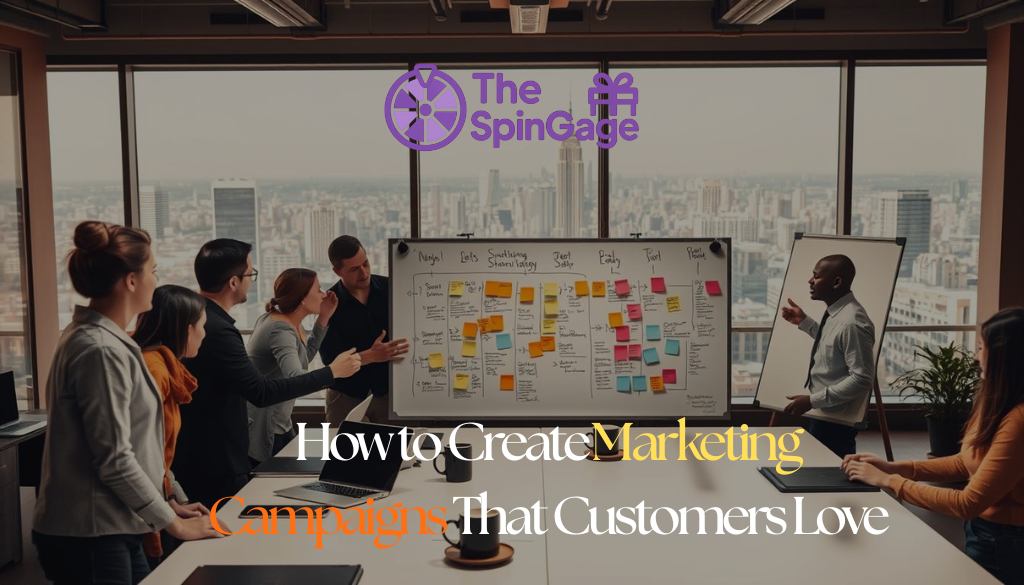


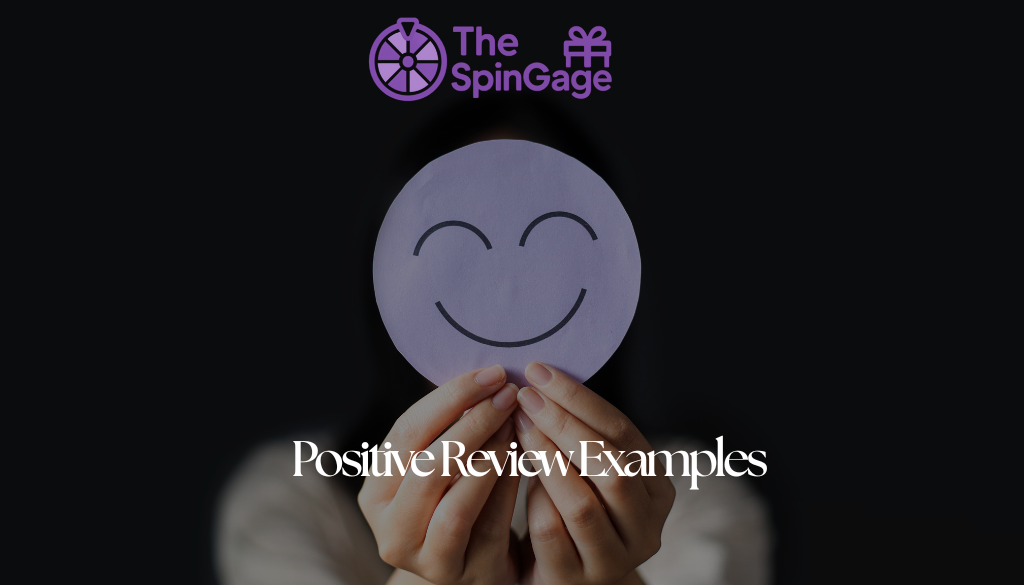
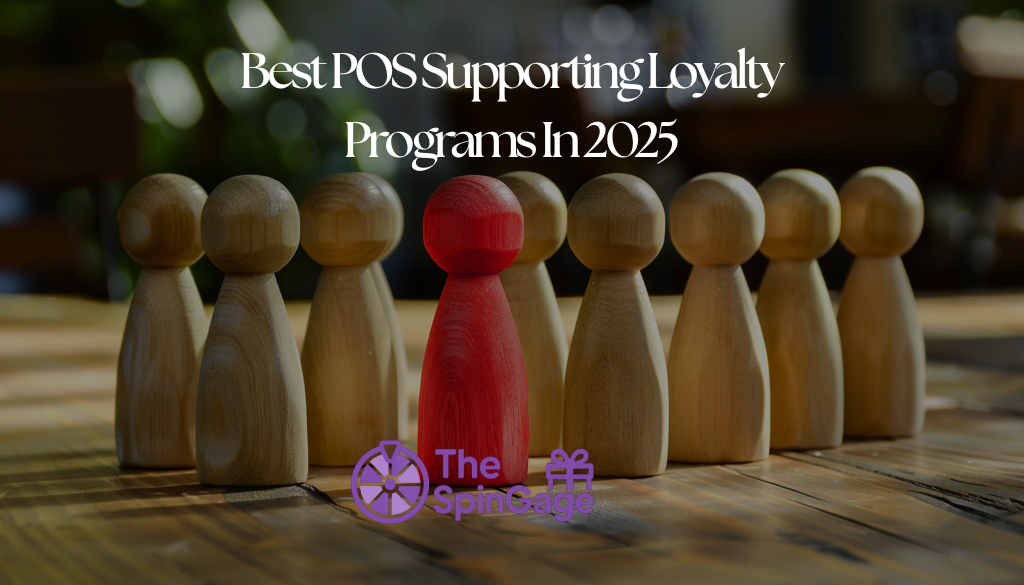
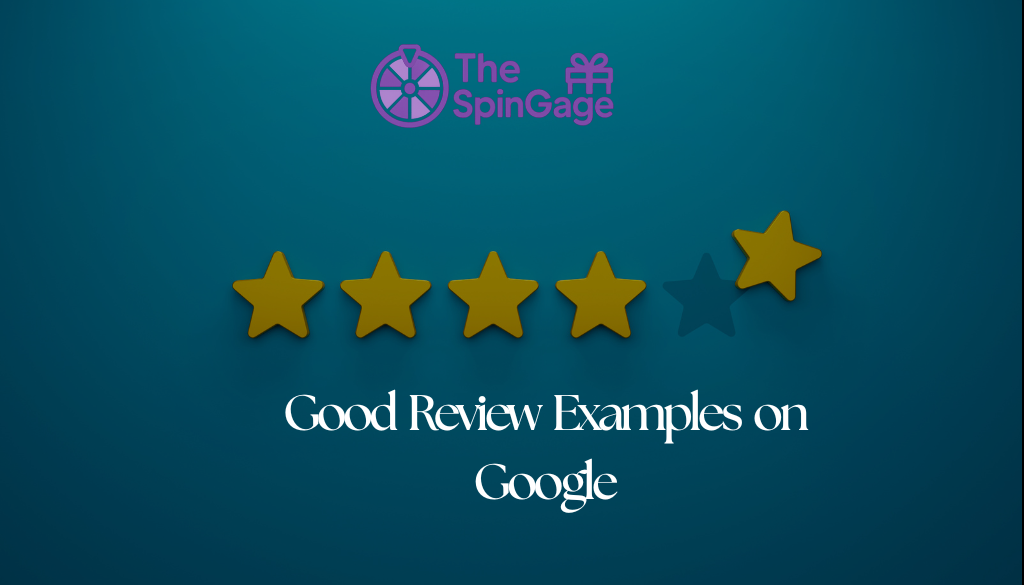

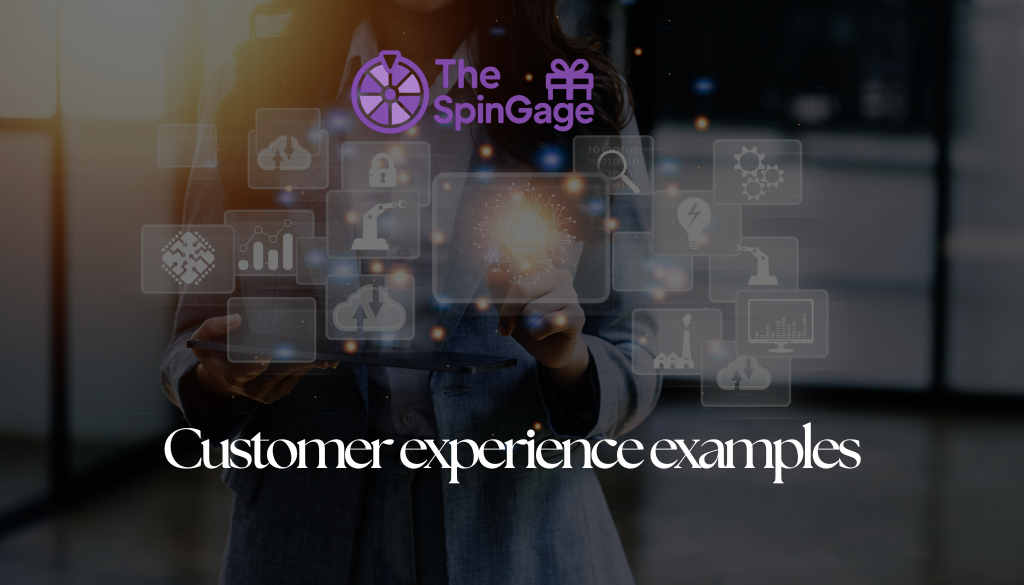

Leave a Reply